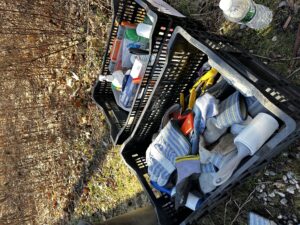Written By: Ru Xue Jiang
The AYLUS Dix Hills Branch works with the Saturday Stewards to continue our joint goal of contributions to developing the environment to be more biologically diverse, the ecosystem has restored a large portion of its function for nutrient cycling, providing habitat for native wildlife, supporting pollinators, and improving soil quality. The success of the volunteering was celebrated with the 100th Saturday Stewardship event! There’s been greater biodiversity of native plants and cohesive plant growth. During this event, volunteers remove the Japanese Knotweed, Yellow Flag Irises, and Greenbrier. Furthermore, volunteers were removing deadwood to ease the process of planting native species in the future.
The removal of invasive species contributes greatly to the restoration of the ecosystem. Invasive species are non-native organisms that have the potential to cause harm to the environment, economy, or human health. These species can be plants, animals, or microorganisms, and they often have a competitive advantage over native species because they lack natural predators or competitors in their new environment. Invasive species can displace native species, disrupt ecosystem functions, and cause other environmental and economic problems. Managing invasive species is an important challenge for conservation and natural resource management. The focus of the event is the environmental restoration pertaining to plants.
Herbaceous perennial Japanese Knotweed grows in enormous colonies of upright, arching stems. Resembling bamboo, they are round, smooth, hollow stems with reddish-brown blotches. The stature of these plants take over large areas surrounding it, diminishing the ability of native species to reach sunlight and live. Because the winter season is transitioning to the growing season of spring, to allow some of the newly planted as well as pre existing native plants to have greater survivability, while the Japanese Knotweed is dead volunteers are hacking it down. This will allow native plants to reach more water supplies, more nutrient supplies, and sunlight.
Yellow flag irises (Iris pseudacorus) have several negative impacts on surrounding native species, including competition for resources, hybridization, and reduction in pollinator diversity. They can grow quickly and form dense stands, which can outcompete native plant species for resources such as sunlight, nutrients, and water. This can lead to a reduction in biodiversity and a loss of native plant species. Moreover, they hybridize with other Iris species, including some native species. This can result in the production of hybrid offspring that may have lower fitness or be less adapted to local environmental conditions. Plus, the Yellow Flag Irises are not preferred by many native pollinators, and their presence can lead to a reduction in the diversity of pollinator species in the area.
Greenbrier (Smilax spp.) has thick roots that travel along the surface of the subterranean, strangling and tangling with other plants, and has sharp thorns protruding along the stem of the plant. The roots can spanned meters long with multiple points of stem growth allowing it to take up precocious amounts of water necessary to other plants. This is further exemplified as it usurps surrounding connection to water of other plant roots by wrapping around them.
The contribution of AYLUS Dix Hills members in the removal of these species have allowed the ecosystem to breathe as well as thrive.
Volunteers: Ru Xue Jiang (3 hour), Jason Cheng (2 hours 30 minutes), Ming Chen (2 hours 30 minutes), Jonny Chen (2 hours), Helen Chen (2 hours), and Christina Mink (2 hours).


















